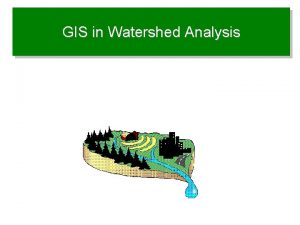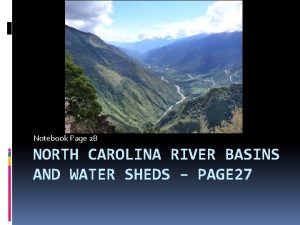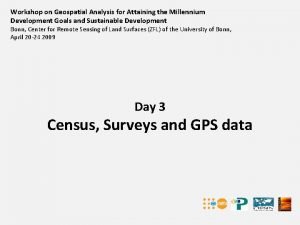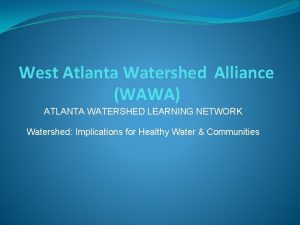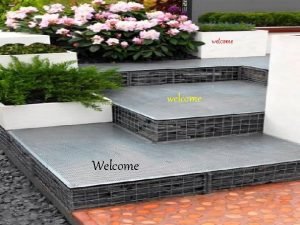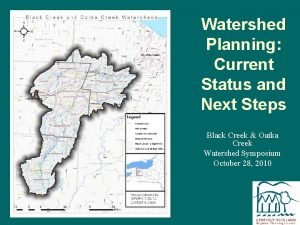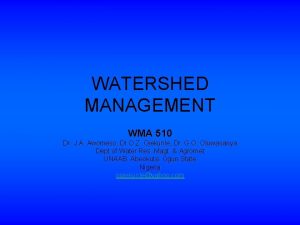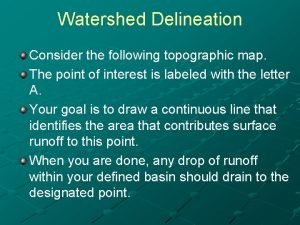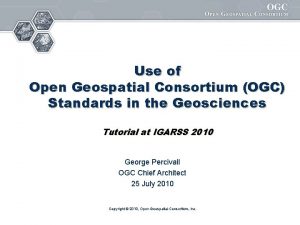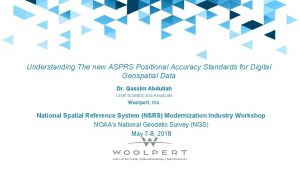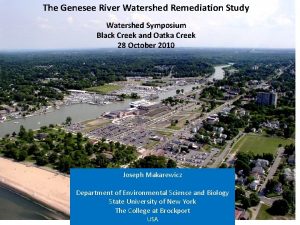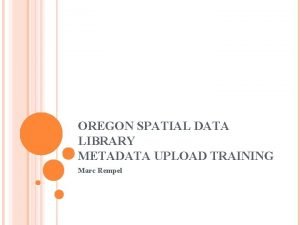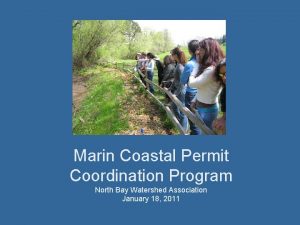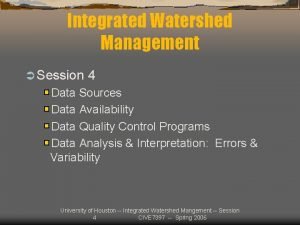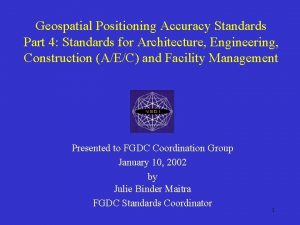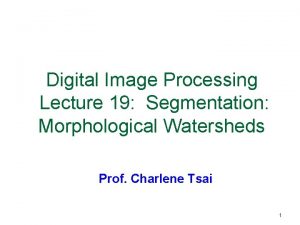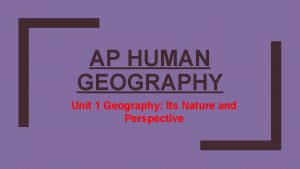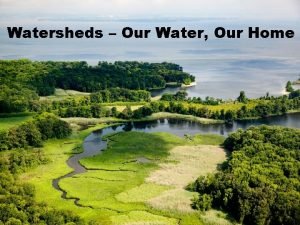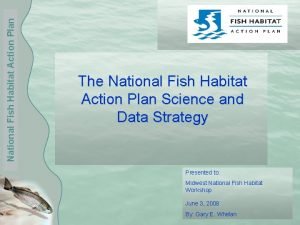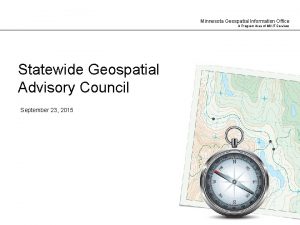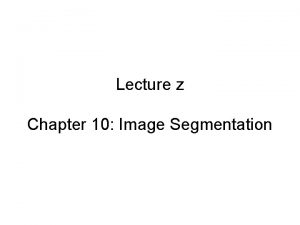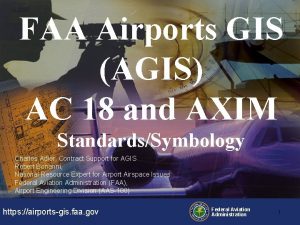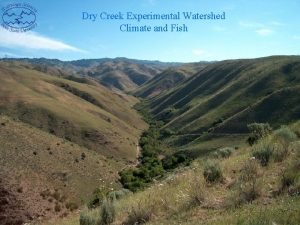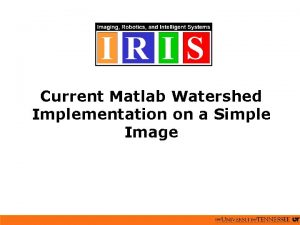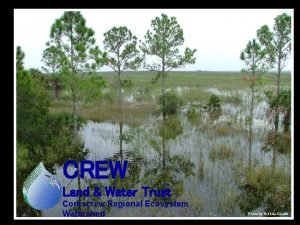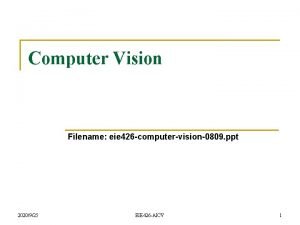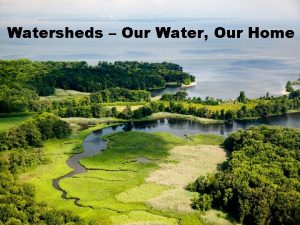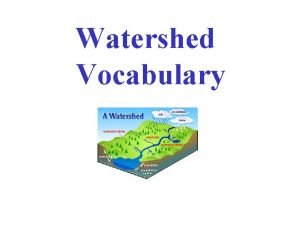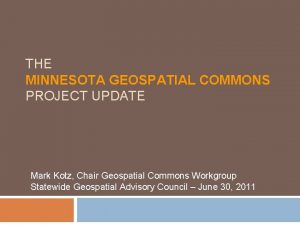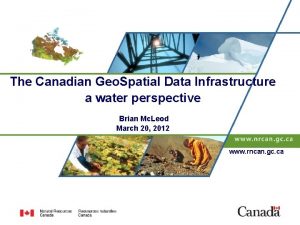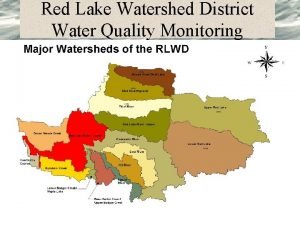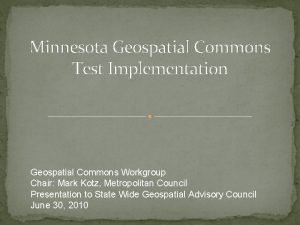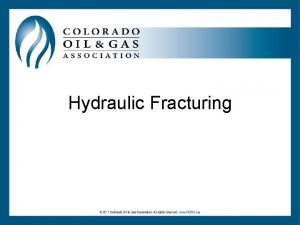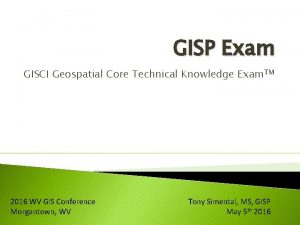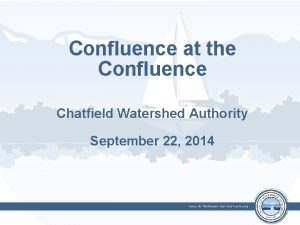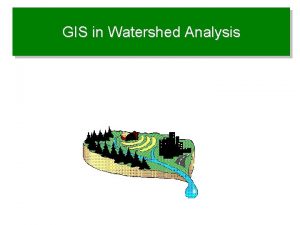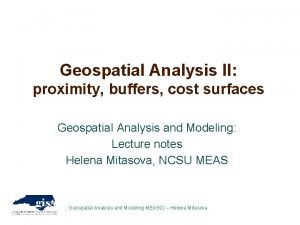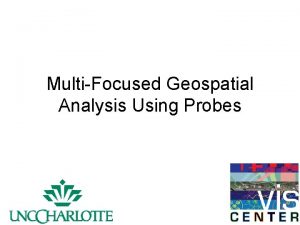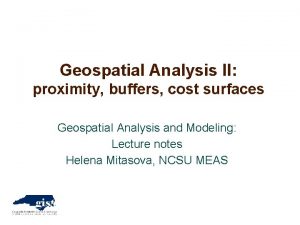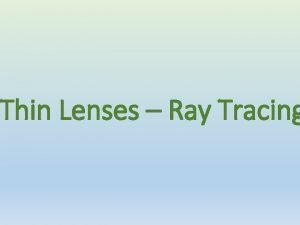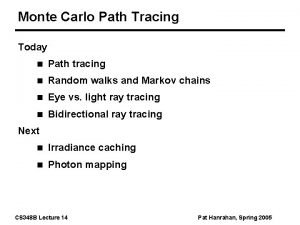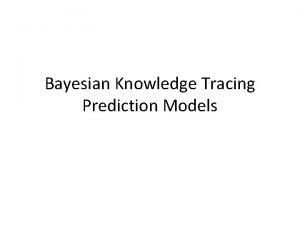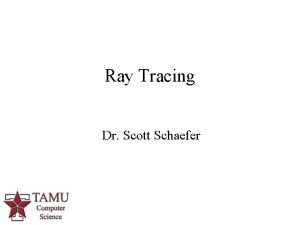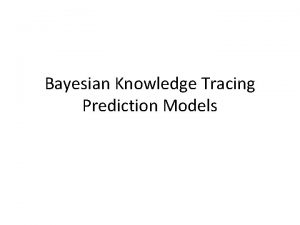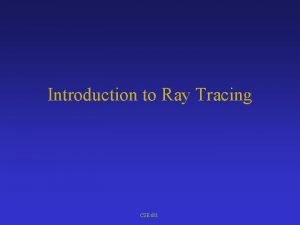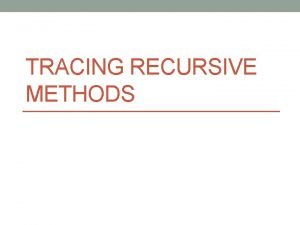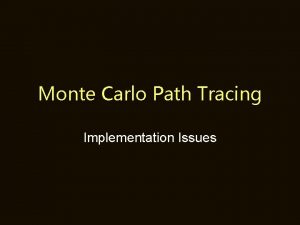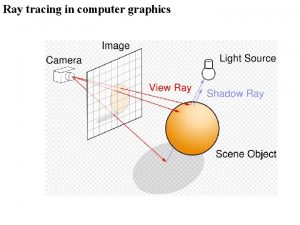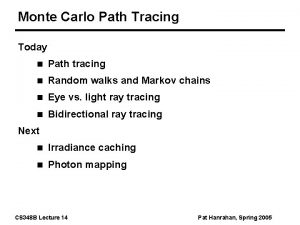Flow tracing and watershed analysis Geospatial Analysis and















































- Slides: 47

Flow tracing and watershed analysis Geospatial Analysis and Modeling: Lecture notes Helena Mitasova, NCSU MEAS

Outline • cumulative terrain parameters based on flow tracing: flow path length, flow accumulation, • methods for computing flow direction (D*8, Dinf), flow tracing (SFD, MFD, uniform, weighted) • methods for flow tracing through depressions and flat areas • extracting watershed boundaries, computing watershed hierarchies

Cumulative flow parameters Parameters and features: • flow path length, • flow accumulation and stream networks • watersheds and ridge lines Computed using flow lines

Cumulative flow parameters Computed using flow lines • follow gradient direction (steepest slope) • perpendicular to contours

Computing flow direction What is flow direction? How to compute it? D-8 and D-infinity

Computing flow direction: D 8 algorithm: • uses 8 directions representing aspect discretized to 0, 45, 90, . . . degrees • estimated from elevation differences between the given grid cell and its 8 neighboring cells

Computing flow direction: Dinf D-infinity or vector-grid algorithm uses a floating point value of aspect estimated by approximation function (e. g. polynomial or spline)

Flow routing Tracing flow in the gradient direction to compute • flow path length • flow accumulation

Flow path length • length of the flow line from the given cell to the outlet used to compute time to concentration (steady state flow) • hillslope length - from the given cell to a flat or depression, used for erosion modeling using Universal Soil Loss Equation (USLE) measure of steady state flow depth for a uniform hillslope

Flow path length • how far is the given cell from the outlet • what is the length of a hillslope above a given cell

Flow accumulation • number of cells draining into a given cell = number of flow lines passing through each cell • size of the upslope contributing area (horizontal, in cell units) • measure of steady state flow depth

Flow accumulation measure of steady state flow depth when raindrop from the farthest grid cell reaches the outlet

Flow routing: methods • single flow direction (SFD) moves entire unit of flow into a single downslope cell: flow dispersal on hillslopes with convex tangential curvature is not captured • multiple flow direction (MFD) partitions flow into two or more downslope directions • both can be implemented with D 8 or Dinf

Flow accumulation: D 8 High resolution DEM: SFD D 8

Flow accumulation: D 8, Dinf High resolution DEM: SFD D 8 and Dinf

Flow accumulation: SFD, MFD High resolution DEM: MFD D 8

Flow routing: methods • uniform: one unit is routed from each cell • weighted: each cell is assigned weight proportional to amount of water it produces (rainfall excess available for runoff) , e. g. based on soil properties or land cover

Flow accumulation: weighted 30 m DEM < flowacc. SFD D 8 uniform

Flow accumulation: weighted 30 m DEM < flowacc. SFD D 8 uniform Landuse>

Flow accumulation: weighted 30 m DEM < flowacc. SFD D 8 uniform Landuse> Weights> (rainfall excess) < weighted flowacc.

Stream extraction • Semi-automated stream mapping: extracting connected stream network from flow accumulation map using selected threshold • Stream raster map is derived using map algebra • Result is converted to vector representation • Stream origin is dynamic, often driven by groundwater: additional information is needed – curvature – groundwater, geology

Flow accumulation: stream extraction Flow accumulation from 30 m NED, method: SFD D 8 and a vectorized extracted stream network

Flow accumulation: stream extraction Flow accumulation from SRTM 90 m and IFSARE 10 m DEMs patched together and reinterpolated to 30 m resolution method: SFD D 8

Stream networks from SRTM Stream network and watershed boundaries from SRTM DEM Flow through large water bodies is indicated by straight stream segments: routing through flats method: SFD D 8

Flow routing: flat areas • to create connected stream network flow needs to be routed through flats and depressions • integer DEMs, lakes or filled depressions create flat areas • flat areas: zero slope and undefined aspect • solutions: – iterative assignment of direction from the first draining cell – imposed gradient (small change in elevation)

DEM depressions • depressions “trap” flow • sources of depressions: – real features – noise, measurement errors – artifacts from processing

Treating depressions • routing through false depressions: • filling fill-in works well for small depressions

Treating depressions • routing through false depressions: • filling, carving fill-in does not create flats carve-in

Treating depressions • routing through false depressions: • filling, carving, hybrid, fill-in hybrid carve-in

Treating depressions • routing through false depressions: • filling, carving, hybrid, least cost path fill-in least cost path hybrid carve-in

Treating depressions Depressions in lidar-based DEM Flowaccumulation: MFD with depr. filling

Depressions in IFSARE DSM River profile from SRTM DEM

Filling for IFSARE DSM: DEM+vegetation and structures, depressions due to gaps in vegetation 3 D view of the original and filled DEM with streams derived by Rivertools

Resolving large depression in IFSARE DSM most common approach: fill-in least cost path Both are SFD, D 8, 10 m resolution DEM

Comparison of algorithms r. watershed: least cost path r. terraflow fill in rivertools fill in measured sites all are SFD D 8

Treating depressions: carving • modifying DEM along with interpolation or flowrouting • carving based on stream data • hydrologically conditioned DEM: no depressions • NOT hydrologically correct - all potential wetlands are removed 50 ft NCFMP DEM

Stream extraction: accuracy Measured as horizontal accuracy of stream centerline or stream banks for large rivers • topographic maps - the lowest accuracy, old • extracted from lidar-based DEMs - better, but accuracy low in coastal plane, improvements expected with new lidar mapping • digitized from high res orthophotos and on ground surveys - most accurate except forested areas • structures require additional information (bridges are represented as dams in DEMs)

Flow lines up and down dowslope flowlines converge in valleys upslope flowlines converge on ridges

Flow lines upslope: dune ridges upslope flowlines - converge on ridges change in ridge mean slope indicates whether dune is stabilizing angle between ridge and crest: transformation from crescentic to parabolic

Watersheds • watershed - important land management unit • water and mass from a watershed drains to a single point: outlet • other terms for watershed: (drainage) basin, catchment, contributing area • watersheds can be organized into hierarchies based on the size of contributing area USGS Hydrologic units: drainage areas of major rivers or multiple smaller rivers: see more at http: //water. usgs. gov/GIS/huc. html

Watershed boundaries GIS watershed analysis: • find watershed boundaries for a given outlet contributing area from which water flows into a given grid cell or stream segment • partition area into watersheds with the given approximate size

Watershed boundaries • methods: same as for flow accumulation • starting from outlet, trace all cells going upslope using reversed flow direction and classify them with ID • snapping outlet to the stream - why it is needed • incomplete contributing area - given DEM does not cover entire drainage basin - flow accumulation and contributing area cannot be computed (handled e. g. , as negative values of flow accumulation)

Watershed boundaries exterior and interior watersheds in urban area highway

Watershed hierarchies interior and exterior subwatersheds

Watershed for a given outlet Contributing area: flowaccumulation*cell area Watershed boundaries traced from a given outlet

Watershed and stream data • EDNA - hydrologicaly relevant parameters from DEMs http: //edna. usgs. gov/ • Hydro. SHEDS worldwide watersheds and rivers based on 15 sec DEM derived from 90 m SRTM http: //hydrosheds. cr. usgs. gov/ • national hydrologic data set - USGS, from topomaps

Summary and references • Gruber and Peckham 2008, Chapter 7 in Hengl, T. and Reuter, H. I. , 2008, Geomorphometry: Concepts, Software, Applications, Elsevier • Chang Ch. 15, Neteler Ch. 5. 4. 4 • software: – – – JGRASS, Land. SERF Tau. DEM (Arc. GIS and Map. Window extension), TAS Terra. STREAM (for massive data sets), SAGA GIS, gv SIG
 Gis watershed analysis
Gis watershed analysis Curve tracing failure analysis
Curve tracing failure analysis How many river basins are in nc
How many river basins are in nc Millennium geospatial
Millennium geospatial Darryl haddock
Darryl haddock Gabion structure watershed
Gabion structure watershed Components of a watershed
Components of a watershed Watershed management meaning
Watershed management meaning Watershed delineation
Watershed delineation Open geospatial consortium standards
Open geospatial consortium standards Asprs accuracy standards
Asprs accuracy standards Genesee river watershed
Genesee river watershed Oregon geospatial data library
Oregon geospatial data library North bay watershed association
North bay watershed association Integrated watershed management
Integrated watershed management Geospatial business intelligence
Geospatial business intelligence Geospatial world forum amsterdam
Geospatial world forum amsterdam Geospatial positioning accuracy standards
Geospatial positioning accuracy standards Watershed morphology
Watershed morphology Andrew ritchie qc
Andrew ritchie qc Azimuthal projection ap human geography
Azimuthal projection ap human geography Watershed poster ideas
Watershed poster ideas Geospatial commons
Geospatial commons Local watershed definition
Local watershed definition Minnesota geospatial commons
Minnesota geospatial commons Dam construction in digital image processing
Dam construction in digital image processing Watershed development programme ppt
Watershed development programme ppt Green river watershed
Green river watershed Faa agis
Faa agis Bcc geospatial center of the cuny crest institute
Bcc geospatial center of the cuny crest institute Dry creek experimental watershed
Dry creek experimental watershed Pseudocolor matlab
Pseudocolor matlab Wawa menu
Wawa menu Computer vision ppt
Computer vision ppt Lisa ropple
Lisa ropple Watershed poster ideas
Watershed poster ideas Watershed vocabulary
Watershed vocabulary Geo portal
Geo portal Canadian geospatial data infrastructure
Canadian geospatial data infrastructure Red lake watershed district
Red lake watershed district Minnesota geospatial commons
Minnesota geospatial commons Rebecca hug
Rebecca hug Watershed segmentation
Watershed segmentation Watershed management
Watershed management Gisci geospatial core technical knowledge exam
Gisci geospatial core technical knowledge exam The importance of water management
The importance of water management Chatfield watershed authority
Chatfield watershed authority Athabasca watershed council
Athabasca watershed council
